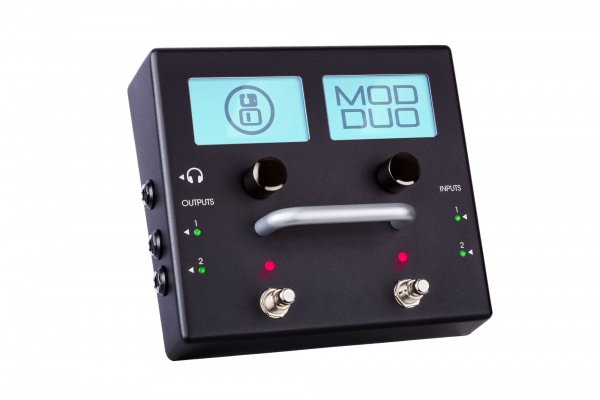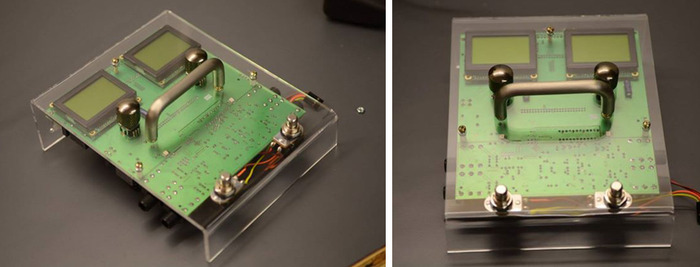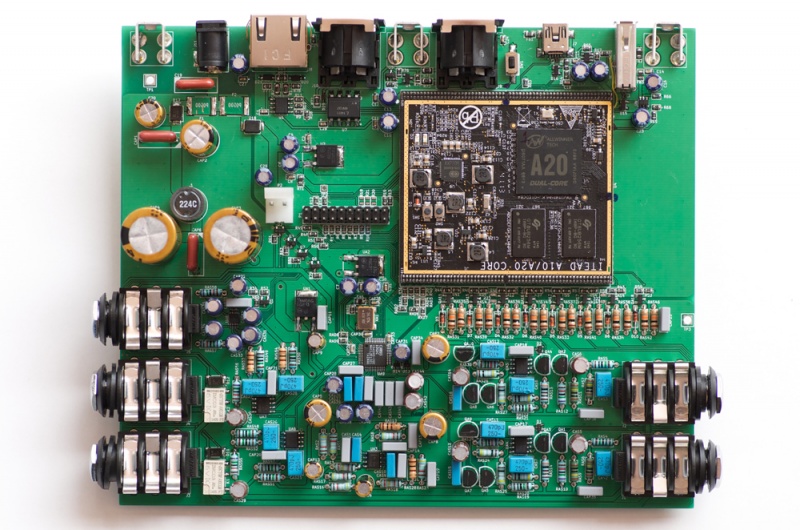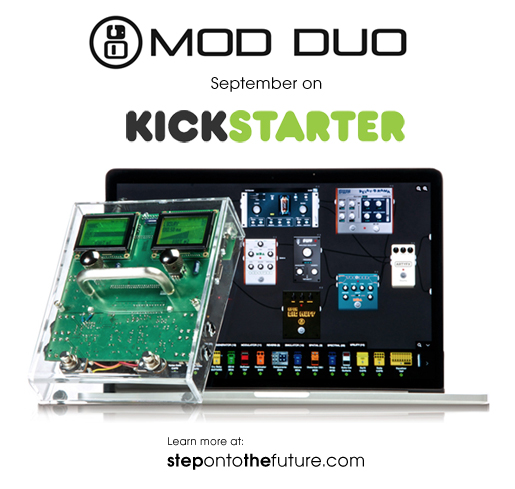|
|
| (14 intermediate revisions by 6 users not shown) |
| Line 1: |
Line 1: |
| − | [[File:MOD Duo blue top view.jpeg|thumb|600px|MOD Duo in blue version, viewed from the top.]] | + | [[File:MOD_DUO_1_leds_on.jpg|thumb|600px|MOD Duo, viewed from the top.]] |
| | | | |
| | == Development == | | == Development == |
| Line 5: |
Line 5: |
| | After a year of engineering, in February 2016, our new product, The MOD Duo has been released. | | After a year of engineering, in February 2016, our new product, The MOD Duo has been released. |
| | | | |
| − | With MOD Duo the MOD entered in a new era. We migrated from the Intel PC architecture to a whole new ARM hardware topology. We also developed the sound card from scratch, following audiophile and high fidelity concepts. And we moved from São Paolo - Brazil, to San Francisco - USA to reach the global market, then to Berlin in Germany. | + | With MOD Duo the MOD entered a new era. We migrated from the Intel PC architecture to a whole new ARM hardware topology. We also developed the sound card from scratch, following audiophile, and high fidelity concepts. And we moved from São Paolo - Brazil, to San Francisco - the USA to reach the global market, then to Berlin in Germany. |
| | | | |
| − | It has much larger graphic displays (2,8 inches), a smaller enclosure to blend with your stomp boxes, two footswitches and two encoders. | + | It has much larger graphic displays (2,8 inches), a smaller enclosure to blend with your stompboxes, two footswitches, and two encoders. |
| | | | |
| − | We launched a crowd funding [https://www.kickstarter.com/projects/modduo/mod-duo-the-limitless-multi-effects-pedal/description kickstarter campaign] to raise funds to produce the MOD Duo. | + | We launched a crowdfunding [https://www.kickstarter.com/projects/modduo/mod-duo-the-limitless-multi-effects-pedal/description Kickstarter campaign] to raise funds to produce the MOD Duo. |
| | | | |
| | We already had working prototypes and a release candidate product. | | We already had working prototypes and a release candidate product. |
| | | | |
| − | Read more in our [http://portalmod.com/products/new website]. | + | Read more in our [http://moddevices.com website]. |
| | | | |
| | [[File:MOD-Duo-instagram.jpg|800px|thumb|left|MOD Duo on [https://www.kickstarter.com/projects/modduo/mod-duo-the-limitless-multi-effects-pedal/description Kickstarter].]] | | [[File:MOD-Duo-instagram.jpg|800px|thumb|left|MOD Duo on [https://www.kickstarter.com/projects/modduo/mod-duo-the-limitless-multi-effects-pedal/description Kickstarter].]] |
| Line 23: |
Line 23: |
| | [[File:MOD-Duo-RC1-PCB-2.jpg|800px|thumb|left|MOD Duo Release Candidate 1 PCB with HI-FI sound card]] | | [[File:MOD-Duo-RC1-PCB-2.jpg|800px|thumb|left|MOD Duo Release Candidate 1 PCB with HI-FI sound card]] |
| | <br clear=all> | | <br clear=all> |
| − |
| |
| − | == Technical specs ==
| |
| − |
| |
| − | === Dimensions ===
| |
| − |
| |
| − | [[File:MOD_Duo_all_views.png|thumb|200px|MOD Duo dimensions in mm]]
| |
| − |
| |
| − | * width: 180 mm
| |
| − | * length: 160 mm
| |
| − | * height: 74.7 mm
| |
| − |
| |
| − | === Inputs and outputs ===
| |
| − |
| |
| − | ==== Audio ====
| |
| − |
| |
| − | [[File:MOD_Duo_blue_side_view.jpeg|thumb|200px|MOD Duo left side view showing the audio and headphone outputs.]]
| |
| − |
| |
| − | * 2 independent inputs:
| |
| − | ** TS connectors
| |
| − | ** Digital input impedance selector
| |
| − | ***line 1 MΩ
| |
| − | ***microphone 3 kΩ
| |
| − | ***instrument 75 kΩ
| |
| − | ** Programmable Gain Amplifier: ± 12 dB Gain, 0.5 dB step plus a 32 dB gain stage for microphone
| |
| − | * 2 independent outputs:
| |
| − | ** TRS connectors (balanced)
| |
| − | ** Volume Control: 0 to -127 dB, 0.5dB step
| |
| − | * Headphone output:
| |
| − | ** TRS connector
| |
| − | ** Digital volume control from +12dB to −33dB
| |
| − |
| |
| − | Each input/output uses a Neutrik® connector, a True Bypass circuit and has a LED whose color depends on the audio signal amplitude.
| |
| − | * signal < -30dB : off
| |
| − | * -30dB < signal < -12dB : green
| |
| − | * -12dB < signal < -3dB : yellow
| |
| − | * signal > -3dB : red
| |
| − |
| |
| − | ==== MIDI ====
| |
| − |
| |
| − | * MIDI IN connector - DIN 5 pins - for musical instruments and controllers
| |
| − | * MIDI OUT connector - DIN 5 pins
| |
| − |
| |
| − | ==== USB ====
| |
| − |
| |
| − | * USB HOST - USB 2.0 Standard-A type
| |
| − | ** USB Bluetooth
| |
| − | ** USB Wifi
| |
| − | ** USB MIDI
| |
| − | * USB DEVICE - USB 2.0 Standard-B type
| |
| − | ** USB Ethernet Adaptor
| |
| − | ** USB Mass Storage (used for updates)
| |
| − |
| |
| − | ==== Controllers ====
| |
| − |
| |
| − | * 2 knobs with LCD screen
| |
| − | * 2 foot switches with color LEDs
| |
| − | * RJ-45 connector for additional controllers (see [[Control Chain]])
| |
| − |
| |
| − | === Processors ===
| |
| − |
| |
| − | *A20 CPU:
| |
| − | ** Dual Core ARM A7 1.0GHz
| |
| − | ** 1 GB RAM
| |
| − | ** 4 GB Flash Storage
| |
| − | * Audio CODEC:
| |
| − | ** Manufacturer: Cirrus Logic
| |
| − | ** DAC: 104dB dynamic range, -90dB THD+N
| |
| − | ** ADC: 104dB dynamic range, -95dB THD+N
| |
| − | ** 24 bit / 48 kHz AD/DA
| |
| − |
| |
| − | === Peripherals ===
| |
| − |
| |
| − | * [[MOD Arduino Shield|Arduino shield]]
| |
| − | * [[MOD_Peripherals#MOD_Expression_Pedal|expression pedal]]
| |
| − | * [[MOD_Peripherals#MOD_Footswitch_Extensor|extra foot switches]]
| |
| − |
| |
| − | === Software ===
| |
| − |
| |
| − | The MOD Duo uses a linux operating system with LV2 plugins to define virtual pedal boards.
| |
| − |
| |
| − | == Utilization ==
| |
| − |
| |
| − | See the [[Quick Start Guide]] to begin using the MOD Duo.
| |
| − |
| |
| − | === Selecting a pedalboard ===
| |
| − |
| |
| − | # Long press the right knob to access the previously saved pedalboards banks
| |
| − | # Turn the right knob to select one of the banks and press to select
| |
| − | # Turn the right knob to select one of the pedalboards and press to select
| |
| − | # Long press the right knob to exit the menu and start using the pedalboards
| |
| − |
| |
| − | === Accessing the settings menu ===
| |
| − |
| |
| − | Long press the left knob, turn to chose the item in the menu (clockwise to go down and counterclockwise to go up) and press to select it. Long press the left knob to exit the settings menu.
| |
| − |
| |
| − | ==== Volume and gains ====
| |
| − |
| |
| − | * Input 1
| |
| − | * Input 2
| |
| − | * Output 1
| |
| − | * Output 2
| |
| − |
| |
| − | Each input and output gain can be set using the following menu.
| |
| − | * Stage: turn the left knob and press it to select the input gain
| |
| − | ** Low
| |
| − | ** Mid
| |
| − | ** High
| |
| − | * Fine adjust: turn the left knob to adjust the input gain from -12dB to 12dB (default 0dB)
| |
| − |
| |
| − | ==== Headphone ====
| |
| − |
| |
| − | * Volume: turn the left knob to adjust the headphone gain from -33dB to 12dB (default -15dB)
| |
| − | * Direct monitoring: press the left knob to switch the headphone direct monitoring
| |
| − |
| |
| − | ==== Info ====
| |
| − |
| |
| − | * Services: press the left knob to see the activated services
| |
| − | ** jack
| |
| − | ** [[MOD Host|mod-host]]
| |
| − | ** [[MOD UI|mod-ui]]
| |
| − | ** ttymidi
| |
| − | * Versions: press the left knob to see the hexadecimal versions of
| |
| − | ** system
| |
| − | ** controller
| |
| − |
| |
| − | ==== System upgrade ====
| |
| − |
| |
| − | # Press the left knob to start the system upgrade process
| |
| − | # Turn the left knob to chose between confirming (YES) or canceling (NO)
| |
| − | # To confirm, press the left knob while holding the left foot switch
| |
| − | # Wait while the MOD Duo enter in restore mode
| |
| − | # Connect the MOD to your PC if not done yet, and wait for a new mass storage drive to appear
| |
| − | # Download the [[MOD Duo Releases|last release]] file from [http://download.moddevices.com/releases/ download.moddevices.com]
| |
| − | # Copy the modduo.tar file into the new drive, and use your OS option to safely remove the drive.
| |
| − |
| |
| − | At this point the MOD Duo will start auto-updating. '''DO NOT TURN IT OFF!'''
| |
| − |
| |
| − | Please wait until the update finishes. The MOD will auto-reboot when the process is complete.
| |
| − | User data will remain untouched.
| |
| − |
| |
| − |
| |
| − | [[category:MOD Duo]]
| |

MOD Duo, viewed from the top.
Development
After a year of engineering, in February 2016, our new product, The MOD Duo has been released.
With MOD Duo the MOD entered a new era. We migrated from the Intel PC architecture to a whole new ARM hardware topology. We also developed the sound card from scratch, following audiophile, and high fidelity concepts. And we moved from São Paolo - Brazil, to San Francisco - the USA to reach the global market, then to Berlin in Germany.
It has much larger graphic displays (2,8 inches), a smaller enclosure to blend with your stompboxes, two footswitches, and two encoders.
We launched a crowdfunding Kickstarter campaign to raise funds to produce the MOD Duo.
We already had working prototypes and a release candidate product.
Read more in our website.

MOD Duo Acrylic Prototype

MOD Duo Release Candidate 1 PCB with HI-FI sound card




